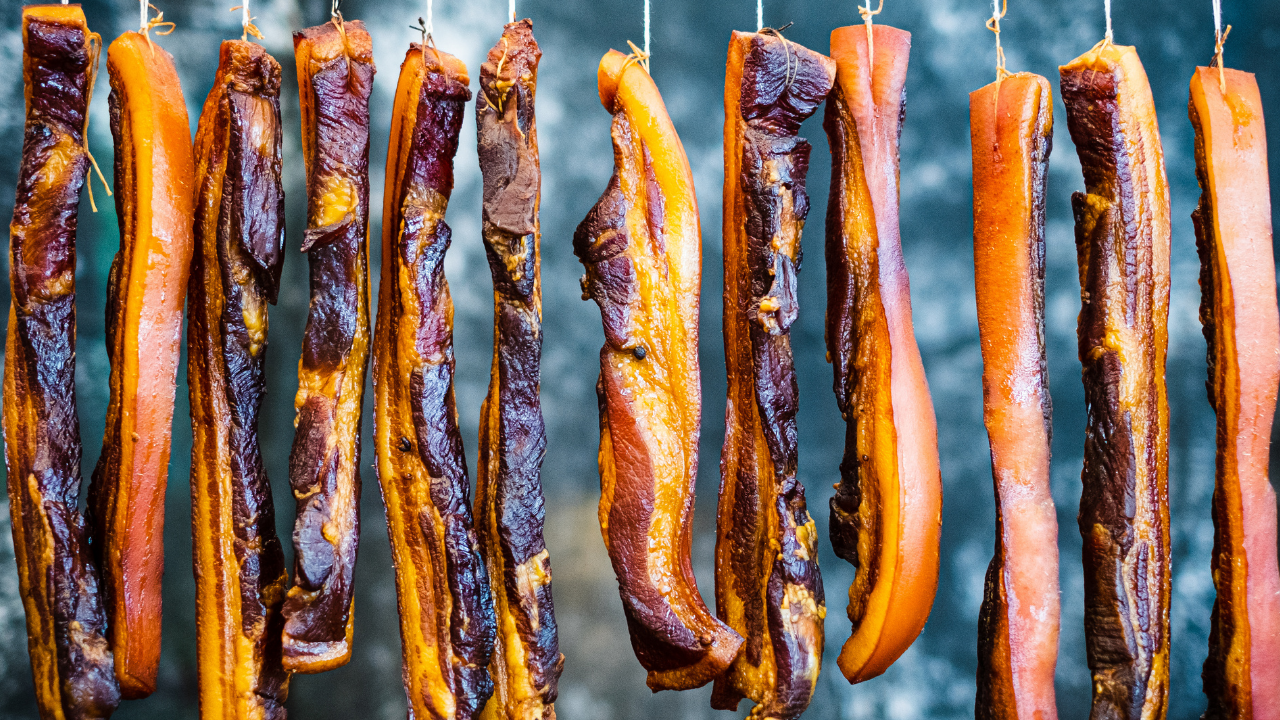My family has a tradition. During the autumn season, we will cure a ton of meat, enough for the next year. We make so many varieties, such as
Sausage (Lap Chang 腊肠)
Cured bacon (Lap Yok 腊肉)
Cured Chicken (La gai 腊鸡)
Cured fish (La Yu 腊鱼)
I made the Cantonese sausage 2 years ago, you can click here to check the recipe. Today, I want to show you how to make Lap Yok because it is a popular ingredient but hard to find outside of China. Once you learn it, you can use it to make a lot of traditional Chinese recipes, such as Clay pot Rice, Taro Root Cake, Cantonese turnip cake, XO Sauce, Cantonese fried rice.

Cured bacon is popular all over China. What makes this recipe Cantonese is the super simple seasoning. In a sauce cup, combine the following ingredients: 3.5 tbsp of salt (preferably sea salt or iodine-free salt), 1 cup + 1/4 cup of sugar, 1 cup + 1/4 cup of soy sauce, 1/4 cup of dark soy sauce, 1 tbsp of Sichuan peppercorn (optional), 1/4 cup of rose cooking wine (optional).

Rose cooking wine (玫瑰露酒), often used in most Cantonese “烧腊” (cured or roasted meat)recipes. It provides a light, refreshing, rose fragrance. This doesn’t affect the taste so you can skip it or replace it with a tsp of editable rose water.

This is a piece of skin on pork belly, skinless also works. Slice it into 1.5 inch wide strips. Some people use pork shoulder, which is much leaner. It works ok but I do want to mention that the difference between Chinese bacon and western bacon is that we will dehydrate the meat, that’s how it stays good for the whole year. It will lose about 30% of the weight. If you use a lean cut, it gets tough and chewy over time. I personally like to use pork belly because those striation layers ensure the meat stays juicy.

Toss the pork belly with 1.5 cup (300 grams) of high alcohol content liquor thououghly. My family uses bai jiu (白酒), which is a colorless liquor, distilled from fermented sorghum. The alcohol content is usually between 35% to 60%. Baijiu is difficult to find outside of China, so I am using vodka. The alcohol content is 50%. Other liquor that the alcohol content is higher than 30% will also work, such as rum or whiskey.

There are 2 purposes for using alcohol when preserving meat. First, it inhibits bacterial growth, which increases the chance of success. Second, although most of the alcohol will evaporate during the fermentation, a small amount will react with the fatty acids and create esterification, which forms esters. That gives lots of flavor to the cured meat.

When all the pork is nicely tossed with the alcohol, transfer it to a different container and leave the excess alcohol behind. Pour the marinade that we just made. Continue to toss thoroughly. FYI, for those who cannot cook with alcohol for religious reasons. The only solution is to skip it and make sure anything that touches the pork is super clean, so you increase the chance of success. The final flavor will be different without the alcohol, but it will still taste delicious.


Alright, the pork is nicely mixed with the seasoning. I like to place a few plates on the top just to give the pork a slight pressure so the marinade can reach more of the pork. We will let it sit in the fridge for 36 hours. Come back every 12 hours and give it another toss to ensure an even marinade.

There are many methods to make lap yok. The traditional way is to hang it outside for 2-3 weeks and you need to be aware of the weather. In Cantonese, we have a saying – 秋风起,吃腊味, which means when autumn winds, eat cured meat. Autumn is the best season to make lap yok. The weather is perfect, it doesn’t rain too much. The wind helps to dehydrate the pork. It is not too hot otherwise you get a lot of flies or bugs when you hang the meat outside. It is not freezing cold either, so it actually allows the fermentation, which is what gives the cured meat the distinctive taste. Another reason we like to make it during the autumn is that when the cured meat is done, it catches the Chinese New Year perfectly.
I really want to show you the traditional hanging method, but south Fl. is too hot for that. I have checked the weather, there is not even one day in the year the temperature is below 60 F. So, I am going to show you the oven method.
However, I have written down the instructions here. If the weather in your area is good, you can give it a try.

Also, here is a dehydrator method, just so you have one more option.

Alright, let’s get back to the oven method. 36 hours later, the pork is nicely marinated and ready to go. Use a sharp little knife to poke a hole through the skin. Be careful, don’t cut yourself. Use a chopstick to help to push the kitchen twine through the hole. Tie it up. Do that to the rest of the pork.

Tie the kitchen twine on the oven rack. Leave some space between them. Be sure to place a big tray at the bottom and line it with tin foil just to catch the drips. My oven is big enough for me to hang the meat. If your oven is small, you can place the pork on the rack, but you will get the rack pattern on one side of the pork, which is completely fine in taste. You can also cut your pork strips shorter in order for you to hang them.
Carefully slide the rack into the oven. We want to dehydrate the pork, not to cook it. You have to use the lowest temperature on your oven. It should be between 120-150 F. My oven can go down to 150 F exactly, which works just fine. If your oven’s minimum temperature is higher than 150 F. You can prop the oven door to keep it slightly open so the actual temperature inside the oven is lower.


This dehydration process will take anywhere between 15-30 hours depending on your oven. This is how mine looks after 20 hours.
The pork strips become much shorter. There is a lot of oil dripped down to the baking tray. That is completely normal.
The texture is firm. The color is nice and brown, really shiny. It smells amazing too. Your lap yok is basically done, and ready for any recipe that asks for Chinese cured bacon.


Let me explain why I do this. There are 3 important things in making Chinese cured pork – seasoning, dehydration, and fermentation. So far, we have only done the seasoning and dehydration. As for the fermentation, you need time for that. There are no shortcuts. I mean, the pork tastes amazing already but letting it sit in room temperature or fridge for a while helps to develop an even more distinctive and complex flavor.
Don’t worry that it will go bad. The high salt and sugar content will keep it good, and it is well dehydrated so it won’t spoil easily.
My family will hang the lap yok on the ceiling right above the firewood stove. Every day, when we cook, we will light up wood, the heat and smoke will help with the preservation. That’s why it stays good for years. However, If you don’t have that type of environment, 2-4 weeks is enough, then you have to freeze it.











































































